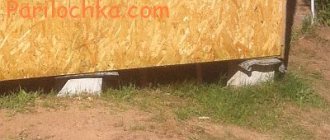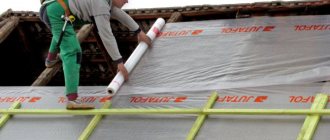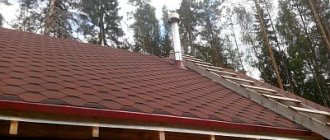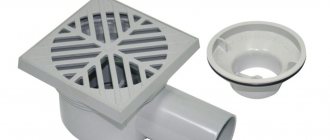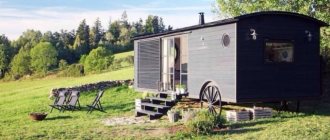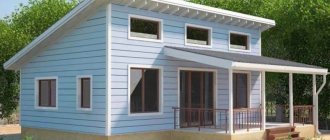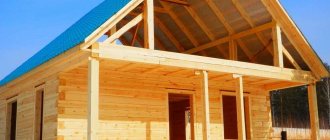What to consider when choosing a roof
Before going to a hardware store to buy material for the roof of a bathhouse, you should carefully consider the possible options, because the roof of such a special structure as a bathhouse must perform several functions at once:
- thermal protective (the roof must withstand high temperatures, while serving as long as possible);
- soundproof;
- aesthetic (fit into the general style of the objects surrounding the bathhouse, maybe even decorating the overall appearance of the yard with an original design);
- protective (to protect the room from precipitation in the form of rain, hail, snow and other atmospheric phenomena, while remaining airtight and durable).
The choice of coating must be made based on the listed main and additional functions that the roof of the bathhouse will perform. In addition, the following factors should also be taken into account:
- the structure of the bathhouse roof, its angle of inclination and configuration;
- the level of precipitation in the area (it is enough to know the average indicator and analyze whether the rafter and load-bearing systems of the bathhouse building can withstand the load of the roof, roofing and, for example, fallen snow);
The level of precipitation in a given area, aesthetics - everything influences the choice of roof for a bathhouse Source krov-torg.ru
- roof covering material for neighboring buildings (garages, houses, sheds, etc.);
- cost of the material (it must “fit” into the budget allocated for the purchase).
If the roof of the bathhouse is a continuous plane, it will be possible to use rolled materials for covering. In the case of using sheet roofing options, for example, tiles, corrugated sheets or slate, it is necessary to pre-lath the roof.
"Grandfather" materials
If the budget for covering the roof of a bathhouse is very small, you can try the so-called old-fashioned methods. These include natural materials such as turf, planks, and wood chips. A feature of these outdated roofing materials is their fairly high fire hazard.
Turf roofing for a bathhouse
For a turf roof you will need the following materials:
- turf (a surface layer of soil that is densely overgrown with herbaceous plants, including meadows or cereals);
- bitumen mastic (a homogeneous mass consisting of bitumen binder, filler, herbicide and antiseptic; it is the basis for the roof);
- gravel (layed after the mastic in a layer of 2-3 cm).
This is what a turf roof looks like after a while Source yandex.ru
See also: Catalog of companies that specialize in roofing materials
The very last layer on the roof is turf. It must be placed evenly on the roof, first with the roots up, after which another layer should be added, but with the roots down. Such a coating for a bath will not only be inexpensive, but also original and environmentally friendly.
Wood chip roof
Chips for a bathhouse are large chips from coniferous trees. When laying, it is important to remember that this material must be well secured to the roof plane, applying it like fish scales, starting from the very top of the roof (for a gable roof - from the ridge). This means that each subsequent element should slightly overlap the previous one.
For a high-quality wood chip roof, it is advisable to lay this wood material in at least 2-3 layers. This work will be quite labor intensive, but it will be worth it. There are two advantages here: it turns out cheap and visually attractive.
Plank roofing for a bathhouse
Timbers are thin boards made from wood of various species and obtained by longitudinal sawing of a log. They are suitable for baths, but do not have a very long service life and are a fire hazard.
Plank roof for a bathhouse Source banya-ili-sauna.ru
For installation, you should first soak the board with bitumen or virgin vegetable oil. Since the thickness of a roof the size of one board will not be enough, you need to lay this material in two layers.
Installation features
An important indicator when installing a roof is the strength and stability of the frame. Roof frame components:
- wooden beam;
- rafter system;
- sheathing;
- roofing material.
When building a bathhouse, be responsible for the vapor barrier. This room must be reliably protected from moisture.
To lay a vapor barrier layer you need:
- Ensure seams are sealed.
- Create a ventilation gap between the finishing and the foil.
- Tape all joints with double-sided tape.
When working, try not to damage the vapor barrier material. If you have holes left from a construction stapler or other materials, additionally seal them with tape.
You can fasten the vapor barrier with a construction stapler or wooden planks. The planks are nailed to the material at intervals of 15-20 cm.
The gap for ventilation should be 2 cm.
With a competent approach to arranging a vapor barrier using the method described above, you will get a reliable design. The steam rising up and collecting on the film will be dried by air passing between the film and the finishing material.
For vapor barrier, use foil products. They will not let steam into the room and will reduce heat loss. Fiberglass based foil is a good choice. Its advantages include:
- high strength;
- non-flammability;
- long service life;
- waterproof;
- environmental friendliness.
When installing a bathhouse roof, proper waterproofing is also important. It will help save money on heating and maintain the desired room temperature.
A gable or single-pitch structure under slate is covered with roofing felt. The roof is first insulated and under-roof waterproofing and internal vapor barrier are carried out.
Roofing felt is laid perpendicular to the rafters of the frame. You need to start laying from the bottom - moving towards the ridge.
Sheets of waterproofing material are applied with an overlap of 15-20 cm.
The waterproofing is attached to the rafters using counter battens. The distance between the slats must be at least 23 cm.
The distance between the slate and roofing felt must be at least 20 cm. This will ensure the weathering of condensation that will form due to sudden temperature changes.
To waterproof the ceiling in a bathhouse, the following are used:
- foil;
- clay;
- polyethylene film;
- membranes.
Modern foil materials provide immediate hydro-steam and thermal insulation.
Clay is used extremely rarely for ceiling waterproofing, due to the availability of modern building materials. But this is the most economical and environmentally friendly material.
Polyethylene film and membranes are in demand. The film does not allow steam to pass through and is therefore used only to insulate the outer layer of insulation.
When choosing waterproofing materials, pay attention to them:
- vapor permeability;
- strength;
- resistance to ultraviolet rays;
- appointment.
If you choose foil, the installation process will be reduced to:
- Fasten the waterproofing layer to the ceiling beams with a construction stapler with a material overlap of 15 cm. Be sure to glue the joints with special tape.
- Next, slats are attached to the beams.
- On the attic side, insulation is laid on the vapor barrier, the thickness of which should be at least 15 cm.
- The last step is the installation of waterproofing polyethylene film. It will need to be laid on the insulation and secured to the beams of the ceiling surface.
Ruberoid as a roofing material for a bathhouse
If the “old-fashioned” methods of covering a bathhouse are not satisfactory and the owner of the building is confused, wondering how to cover the roof of a bathhouse inexpensively and efficiently, it is worth considering cheap roofing felt material. Indeed, now one of the most economical options for roll roofing of a bathhouse remains roofing felt. It is ideal for a roof whose slope angle(s) does not exceed 5°, although, if necessary, you can cover steeper roofs with this material, increasing the number of layers.
This waterproofing roofing material does not look very aesthetically pleasing, but if installed correctly, it can perfectly protect the roof of a bath building from external influences as a water and heat insulator. It weighs little, and is installed easily and quickly using hot mastic and fastening elements of roofing nails.
Ondulin for sauna roof
Ondulin or Euroslate is a thin but hard water-repellent durable roofing covering made from pressed cellulose impregnated with bitumen. Thanks to the addition of coloring pigments to the composition of this material during the production, it has a high aesthetic value: ondulin can be selected in almost any color.
This material is suitable both for covering a bathhouse and for arranging the roof of any other building:
- durable (ondulin will last from forty-five to sixty years);
- durable;
- convenient to use (the weight of each sheet is maximum 7 kg);
- looks attractive (like colored waves);
- resistant to high temperatures;
- sold in sheets of different sizes;
- non-toxic (ondulin is an environmentally friendly material);
- silent (not much noise during rain or hail).
On a note! Ondulin is recommended to be laid on the roof if its angle of inclination is at least 30°.
Ondulin on the roof of a wooden bathhouse Source svoimi-rykami.ru
Flexible tiles. Is it good for everyone?
These soft “tiles”, made of fiberglass, impregnated with bitumen and covered with stone chips, are perhaps the favorite material among professionals. Ideal for installation of the most complex structures.
Moreover, manufacturers began to use modified bitumen, made on the basis of artificial rubber, which gives elasticity and resistance to low temperatures. The latter was one of the main disadvantages of flexible tiles.
But let's look at all the pros and cons of this material.
Pros:
- Service life reaches 70 years or more;
- The coating is UV resistant;
- Not afraid of corrosion;
- Excellent sound absorption;
- Economical cutting of material, virtually eliminating waste;
- Ideal connections of elements, excluding even minimal moisture ingress;
- Convenient repair, allowing you to replace one element without removing a row;
- Resistance to temperature changes;
- Aesthetically presentable.
Minuses:
- The need to install a continuous flooring and a waterproofing “carpet” - do not put flexible tiles on the sheathing;
- Strict requirements for installation conditions in terms of temperature and humidity;
- Tendency to become brittle in very severe frosts;
- The material is bad, but supports combustion;
- The price is second only to natural ceramic coating.
Metal roofing of a bathhouse
It is worth considering the question of how to cover the roof of the bathhouse if you want to use some kind of metal-containing material. For example, it could be metal tiles - a durable but rather noisy coating that heats up very quickly, which is only a plus for a bathhouse. This material is durable: it will last about forty years. The main condition for the long useful use of metal tiles is to be careful with the protective layer of the coating of this building material. Otherwise, the roof will slowly begin to rust.
Metal construction and finishing roofing materials also include roofing steel, corrugated sheeting and seam roofing. Unlike metal roofing, corrugated roofing has a thinner edge, and seam roofing is flat. Roofing steel may not have the protective coating that corrugated sheeting has. It is important to know that all metal roofing elements that are suitable for laying on the roof of a bathhouse are recommended to be laid on roofs that have a slope of about twenty-five degrees or more.
Seam roofing Source falcprof.ru
Roofing steel
You can buy roofing steel for about 20 rubles per sheet. Steel sheets are lightweight and do not require constant maintenance. They are not subject to combustion and have high strength. However, it also has certain disadvantages - very often the steel sheets become covered with rust.
Unique natural material. Very easy to install. You don't need any special skills or tools; the main thing is to follow the simple installation instructions. The average service life, depending on the collection, is 25-50 years. The price, for example, of a single-layer tile, but for a bath you don’t need more, starts from 6 rubles. In addition, soft roofing:
- Does not burn.
- Not susceptible to climate change.
- Not subject to corrosion;
- Does not react with organic formations (needles, leaves, moss, etc.)
- It is light in weight - no need to prepare a serious rafter system.
- Absorbs the noise of rain and other precipitation.
- Not subject to avalanches of snow.
- Does not require serious maintenance (cleaning once a year is enough)
- Large selection of colors, more than 100 colors.
- It is economical, because during installation a minimum of waste is generated.
- Easy repair in case of damage.
If you want to save money and purchase practical, inexpensive material, then flexible tiles are perfect for you.
Slate for bath
Solid, heavy asbestos-cement or bitumen material, called slate, is often used to install the roof of bathhouses and other buildings. Although the reasonable question of what is the best way to cover the roof of a bathhouse can hardly be answered with “slate,” this material is still widely used to this day.
Although slate is fragile, not entirely environmentally friendly (due to the asbestos content) and not very comfortable, and also loses its appearance over time and requires a small angle of inclination (up to twenty degrees, no more), it will last quite a long time - about twenty five years old. Another obvious “advantage” of this material is its fire resistance, which guarantees high fire safety of the bathhouse.
Clay insulation
When insulating a roof with clay, the ceiling must be assembled from dry boards, at least 4 cm thick. All cracks formed during the assembly process are covered with clay without sand.
After the applied solution has completely dried, you need to cover it with a second layer of clay, but you will need to add sand to the solution. The thickness of the applied layer should be at least 5-6 cm.
Clay in its pure form is not used for insulation. It is diluted with straw in the proportion: 2 parts clay, 3 straw, and a little water. The consistency of the solution should be similar to plasticine.
Insulating the roof with clay will prevent the breeding of mice.
The advantages of such insulation include environmental friendliness, cost savings and high thermal insulation qualities.
Briefly about the main thing
So, the question of how to cover the roof of a bathhouse inexpensively is quite relevant for owners of private houses, cottages, and summer cottages.
With all the abundance of roofs and technologies that the modern market of finishing and building materials offers, it is not difficult to determine the right one.
The main thing is to take into account all the most important factors in advance. These include: the purchase budget, weather conditions and personal preferences of the land owner.
Ratings 0
